
Today on the review is a portable charging station EcoFlow River PRO with a capacity of 720 Wh, with the ability to connect solar panels and 2 sockets for a European plug. River PRO is not the highest possible modification, but it is more than enough for the average user. We will talk in detail about the user experience, as well as possible scenarios for using the device.

Packaging and equipment
The station comes in a handy carton box with a plastic handle and foam pads for safe transport.
The kit, in addition to the EcoFlow River PRO itself, includes the following kit:
- Power cable on European plug
- Cable for solar panel connection
- Car charging cable
- Instructions and warranty card
It is worth noting that at the moment you can connect any solar panel from third-party manufacturers, the user is not limited in this. Alternatively, you can purchase a panel from EcoFlow, which comes with a handy case for transport and location in the field, as discussed below. Also, from interesting additional options, it is possible to purchase a battery pack, without a controller, which is connected with a special cable to the main unit, increasing its volume.
Design and ergonomics
Appearance can be described as strict, without unnecessary details, but not utilitarian. In general, the entire EcoFlow River line looks like an interesting gadget that you want to click and examine in detail, and not like an ordinary giant power bank. The body of the station consists of carbon fiber with a matte non-scratch surface.

The front panel contains a display with the following information:
- how many hours the charging station will work (changes in real time, depending on the amount of energy consumed)
- battery percentage
- input power W
- output power W
- connected inputs
- wifi indicator

Ergonomically, EcoFlow River PRO is somewhere in the middle between the simplest and maximum versions of charging stations (which was one of the main criteria when choosing a station for review). Even a child can easily move a small box from place to place – the device weighs 7.6 kg, but thanks to a comfortable handle and competent weight distribution, it feels like 4-5 kg.
EcoFlow River stands on 4 rather high rubber feet, which securely adhere it to almost any surface and leave a small gap between the surface and the bottom of the case.
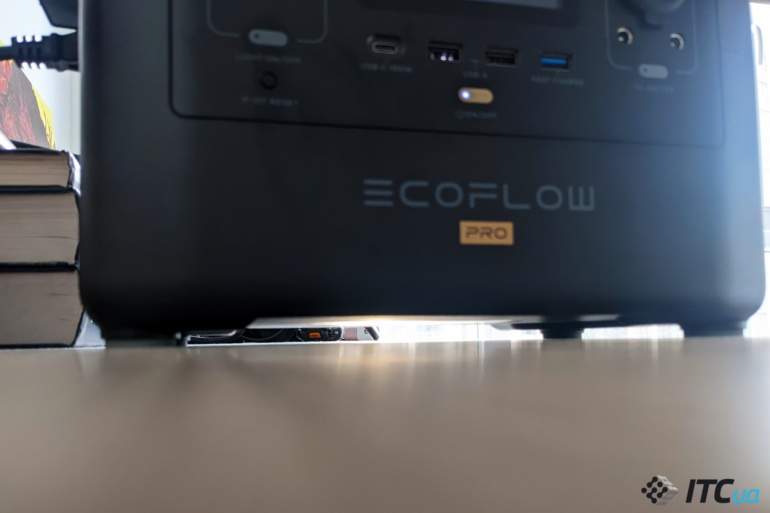
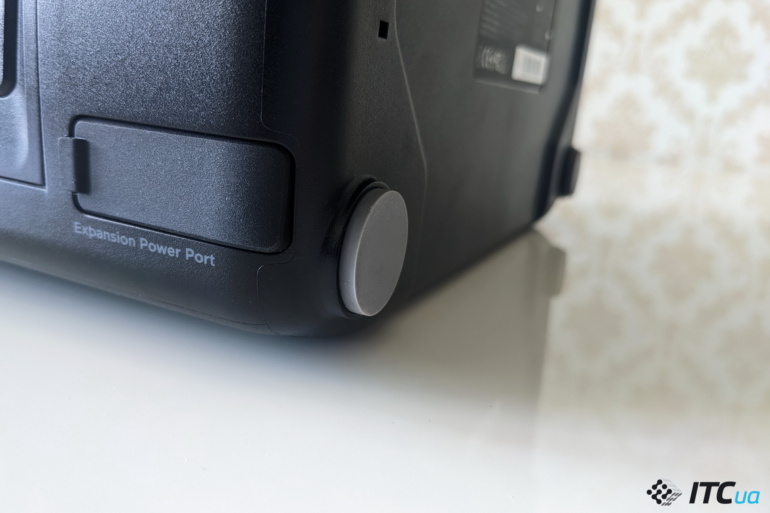
Ports
On the front of the charging station is:
- LED flashlight with 3 light modes (dim, normal and SOS)
- Information display
- USB-C 100W fast charging (5V/9V/12V/15V/20V, 5A, 100W)
- 2xUSB-A (5V, 2.4A, 12W)
- Fast USB-A (5V/9V/12V, 28W, 2.4A)
- Car socket (136W, 13.6V, 10A,)
- Ports 2xDC5521 (13.6V, 3A)
On the left side:
- X-STREAM Charge Port
- Reload button
- Port for connecting solar panels
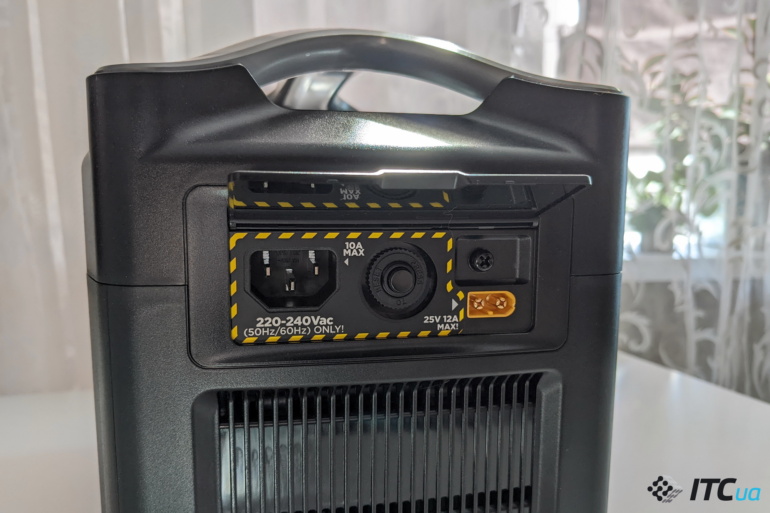
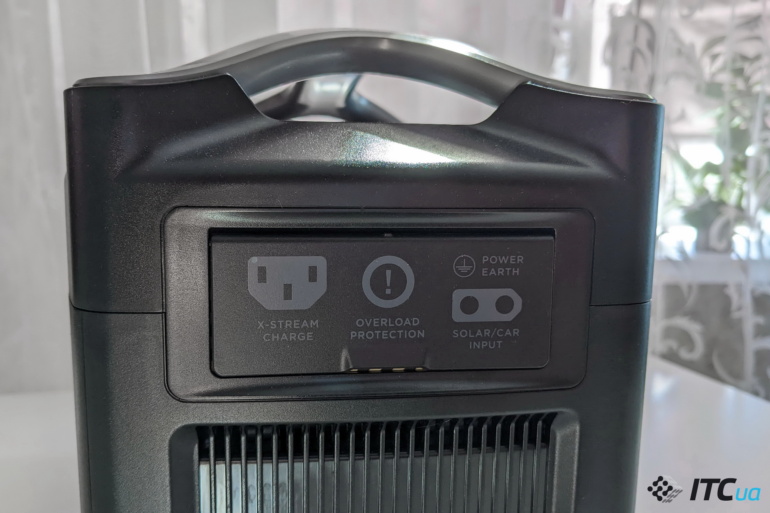
On the right:
- 2 sockets per EU plug 220-240V (50/60Hz), power 600W (surges up to 1200W)
- Ventilation grill for coolers
- Port for connecting additional batteries
The back face is empty, and on the bottom there are 4 rubberized legs, a serial number and a short list of characteristics.


Specifications
Battery type: Li-ion
Battery capacity: 720Wh or 200,000mAh (3.6V)
Charging time: 1.6 hours
Body material: carbon fiber
Device connection: USB Type-A, USB Type-C, 12 V auto socket, 230 V socket
Body color: black
Dimensions: 28.8×18.5×23.5 cm
Weight: 7.6 kg
Output current and voltage:
- 2 sockets 220-240 V (50/60 Hz), power 600 W (surges up to 1200 W)
- USB-A fast charging: 5V/9V/12V, 28W, 2.4A
- car socket: 136W, 13.6V, 10A
- USB-A port (2 pcs.): 5V, 2.4A, 12W
- Type-C port: 5V/9V/12V/15V/20V, 5A, 100W
- DC5521 port (2 pcs.): 13.6V, 3A
Input current and voltage:
- charging voltage 220-240V (50/60Hz) 660W
- solar battery: 200W, 10-25V, up to 12A
- car charger: 12V, up to 10A

Appendix
The charging station can also be controlled via an app. In order to use it, you need to go through a simple registration, connect via Wi-Fi to the station and give it access to the nearest point.
After that, you will be able to monitor all systems, manage parameters, their flexible settings, as well as the ability to update the device firmware. You also get the ability to remotely control the station: turn sockets on and off, change the output voltage, turn on the flashlight and activate X-Boost for devices with increased power consumption.
The application is smart, works without lags, the interface is pleasant and informative, but after updating the firmware of the charging station, it began to fall off the application, so it had to be reconnected from time to time. The Ukrainian language was not delivered, but I think this will be corrected in the future.
Price, modifications and main accessories
To date, the cost of a survey EcoFlow River PRO for 720 Wh is 31,390 UAH . Personally, for myself, I would rather consider a simpler version, since for my scenarios of using EcoFlow River at 288 Wh for 16,820 UAH it would be quite enough, but, in addition to the difference in battery volume, it does not have a connector for connecting additional battery packs, so that this option is not suitable for all users.
Of the most interesting accessories, in addition to protective cases, cases and other options, it is worth highlighting solar panels and the ability to connect additional battery packs. Their connection is carried out through separate special ports, and the very presence of such improvements significantly expands the capabilities of the station.
For example, using even a minimal 110W panel already makes it possible not to depend on an outlet. The efficiency of the solar panel is approximately 22%, and it can be used to fully charge the EcoFlow River PRO in 9-18 hours, depending on weather conditions. With rather modest dimensions of 51.4x158x 2.4 cm and 4 kg of weight, this is quite good. True, such a pleasure will cost 13 thousand UAH, but the user still has the opportunity to use third-party solar panels, so this is a matter of choice. Personally, the author would be more comfortable using branded panels, but the price tag bites a lot, given that this is the minimum EcoFlow Solar Panel configuration.
EcoFlow 160W Solar Panel costing UAH 16,820 will charge the station in 6-12 hours, and EcoFlow 220W Solar Pane will cost UAH 24,999, but will charge the observation station in 4-8 hours.
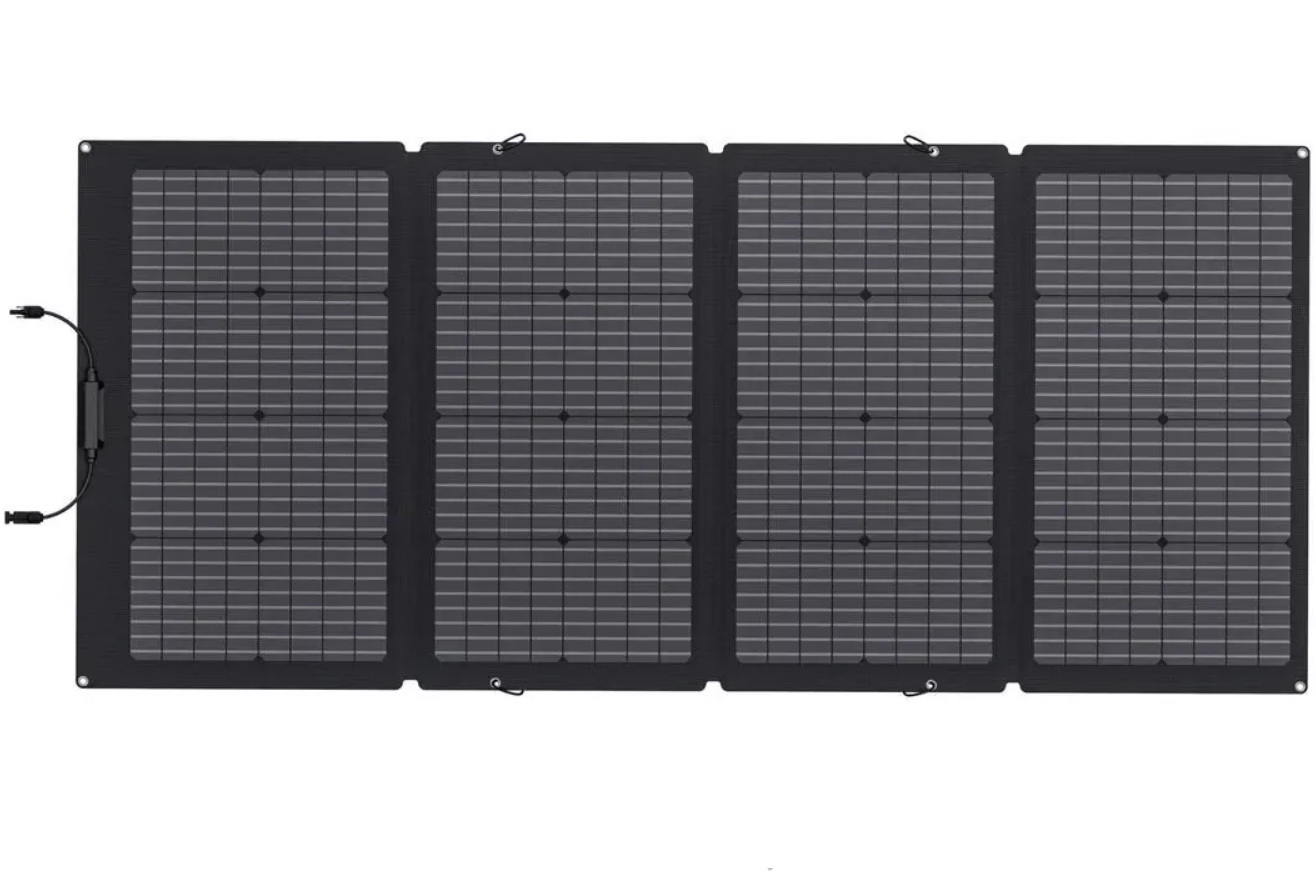
The most powerful EcoFlow 400W Solar Panel currently available at a cost of UAH 44,850 is designed for older models of charging stations, but with its impressive cost, one such panel will charge EcoFlow River DELTA Pro at 3600 Wh or 1,125,000mAh (3.2V) in total in 12-24 hours, and this is already an application for providing electricity to a small country house.
By the way, solar panels can be connected in parallel. They can also be installed on special trackers that will choose the optimal position relative to the sun and provide the highest possible efficiency (which will cost another UAH 150,999).
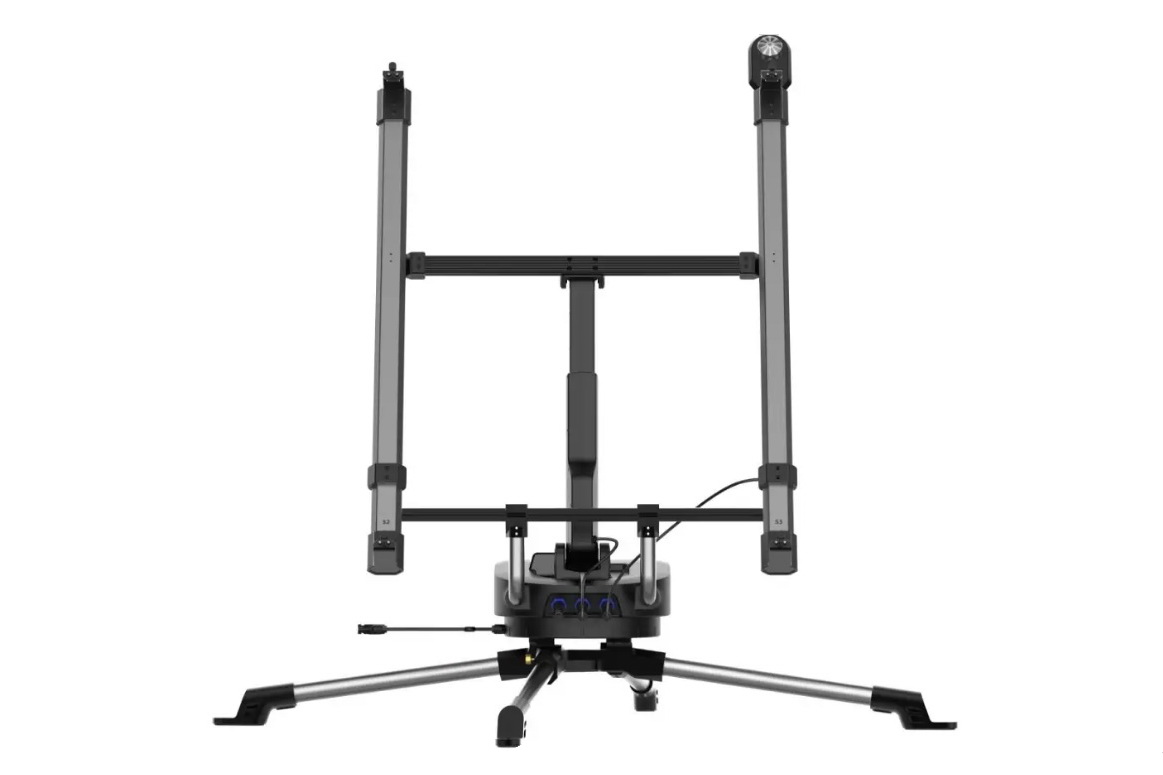
It is also possible to purchase a separate battery pack, for example, EcoFlow RIVER Pro Extra Battery for 720 W/h, costing UAH 21,300, to expand the capacity of the station. This option seems to be the most flexible, since you can use the minimum configuration of charging stations separately if the user often needs a small volume and mobility is a priority, and if necessary, you can always take an additional unit with you. There can be several such blocks in one chain, so their number can be varied depending on the tasks.
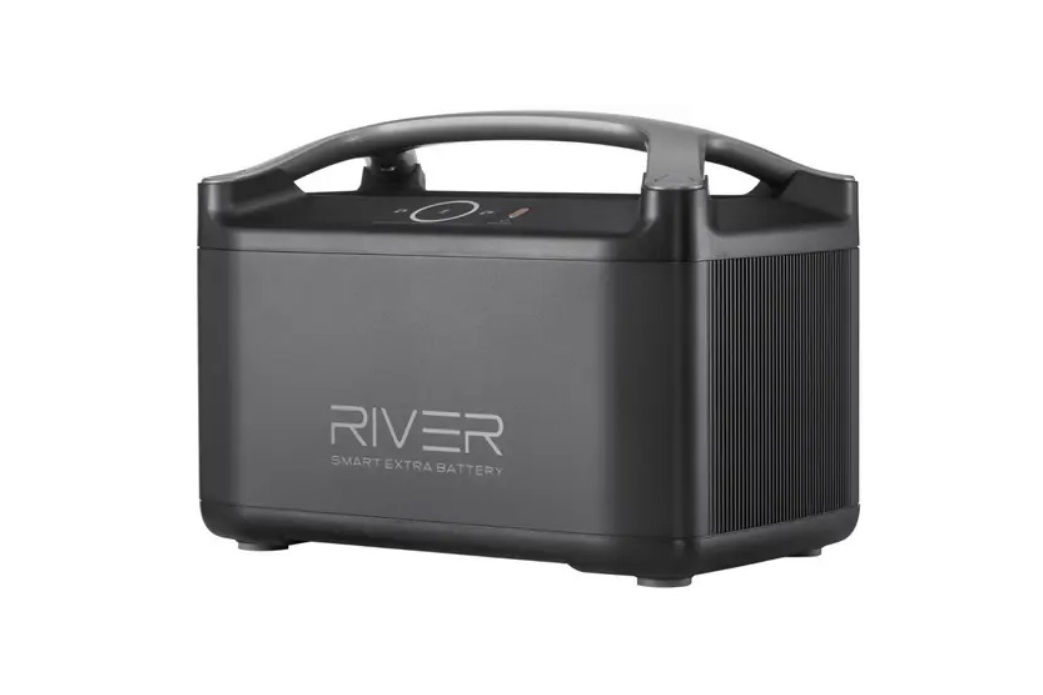
Battery and user experience
Let’s start with the first plug-in, which means the first charge, as EcoFlow arrives with a 30% charge, for better preservation of Li-ion batteries. From 30% to 100% EcoFlow River PRO from a home 220V socket is charged in 1 hour 17 minutes (the station display showed an estimated time until the end of charging 56 minutes). From 0% to 100%, the station charges in 1 hour 49 minutes.
It took 4-5 days of active use to completely drain the EcoFlow River PRO, in my most frequent usage scenario, which included: charging a laptop with a 100W charger, charging a smartphone with a 20W power adapter or USB-C fast charging, charging an audio player , charging MiBand 4 via USB-A, occasional use of small household appliances (for experimental purposes), use of lighting devices, as well as frequent use of a flashlight at minimum power. Considering that the station gains a full charge in about 1.5 hours, its volume is more than enough to regularly cover the needs of the average user, to provide electricity to the “field office”.
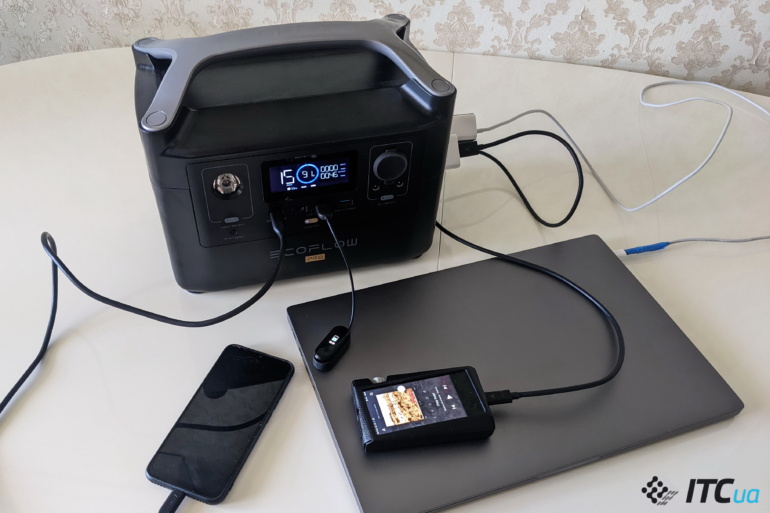
The station charging process is as follows:
- At 0% charge, the station consumes 60-75W during the first 5-10 minutes
- Then at 1% charge, the consumption rises to 150-200W
- At 2% consumption is 340-350W
- At 3-4% 500-550W
- And upon reaching 8% of the charge, the station switches to a constant consumption of 550-580W, which is maintained until the end of the charging cycle, periodically turning on the coolers
By the way, the device can be used and charged at the same time, which is especially convenient when traveling – you can charge the station from the cigarette lighter in the car, and already power gadgets or a refrigerator from the station. Or it’s trite to charge your devices while you wait for the station to charge from the outlet. Also, from non-obvious bonus features – monitoring the consumption of electricity by equipment, since the station shows the current consumption in Watts, the user can track its volumes for each individual device.
You can list possible use cases for a long time, starting with an on-site photo session with connecting all the equipment to one station and ending with field hospitals, but we will consider only those in which the author managed to test the station personally.
And the very first scenario, quite by accident, turned out to be the testing of the Starlink satellite communications system . Coincidentally, both of these devices came to me for review at the same time and there was a need to test Starlink on the street without access to a power outlet. So the first tests after turning it on were charging the smartphone and maintaining the stable operation of the satellite Internet from SpaceX for several hours, which EcoFlow did an excellent job of.
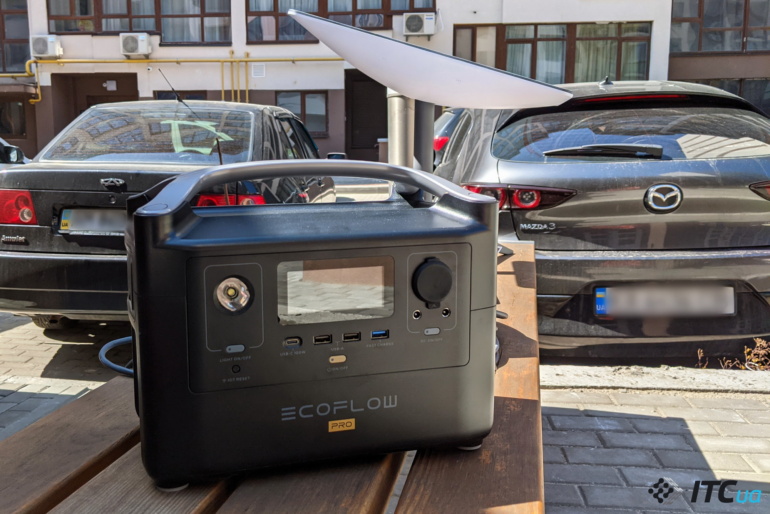
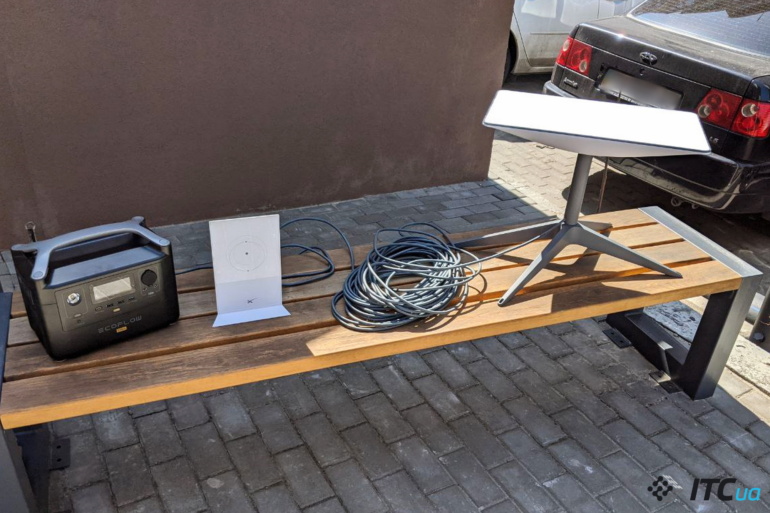
Then there was a test with simultaneous charging of the most frequently used devices, which has already been described above (smartphone, laptop, player). In this mode of consumption from 75W to 200W, the charging station can work for about 10-15 hours, depending on how actively the devices being charged are used. And the work of a combo amplifier paired with an audio player.

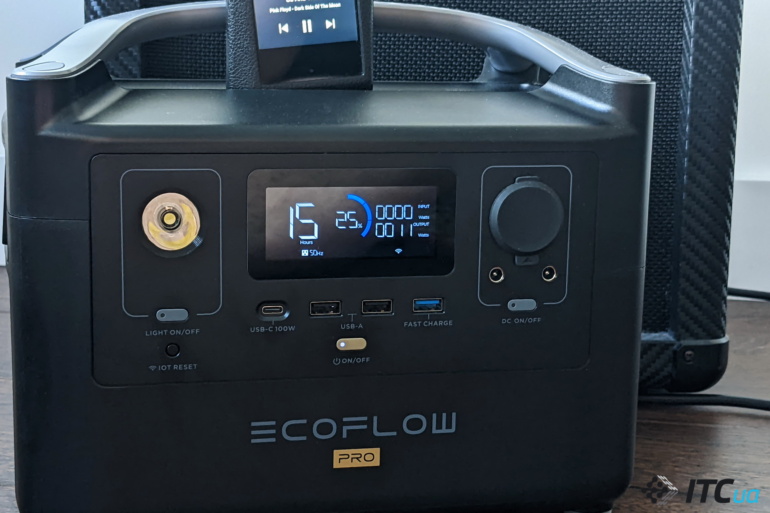
Also, one of the use cases is the operation of the Godox SL60W lighting fixture. At full power, the photo light can be used for 8 hours. If there are two such devices, and photographers, as a rule, use photolight in pairs, then we get 4 hours of full-fledged work, which should be enough for a small outdoor photo session.
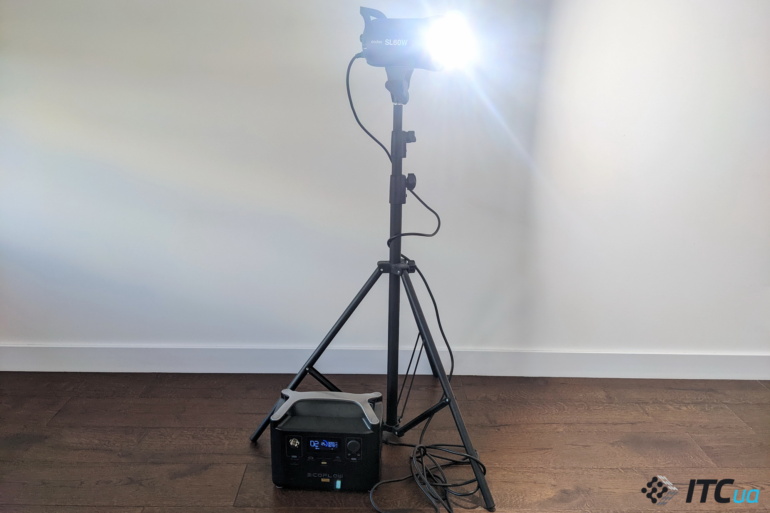

The work of the Panasonic multicooker, as well as the full operation of the Gorenje washing machine, acted as stress tests – everything worked stably, despite the high power consumption reaching 600W during the operation of the multicooker. When used with this technique, I had to activate the X-Boost mode, and if the washing machine did not require it, then when the multicooker was turned on, the EcoFlow River PRO protection worked, immediately turning off the power supply. After turning on X-Boost, everything worked stably, but in this mode of energy consumption, the charging station can last no more than an hour, which, however, is quite enough for cooking.




